- Home
- Robert Graves
The Greek Myths, Volume 1 Page 5
The Greek Myths, Volume 1 Read online
Page 5
7
THE DETHRONEMENT OF CRONUS
CRONUS married his sister Rhea, to whom the oak is sacred.1 But it was prophesied by Mother Earth, and by his dying father Uranus, that one of his own sons would dethrone him. Every year, therefore, he swallowed the children whom Rhea bore him: first Hestia, then Demeter and Hera, then Hades, then Poseidon.2
b. Rhea was enraged. She bore Zeus, her third son, at dead of night on Mount Lycaeum in Arcadia, where no creature casts a shadow3 and, having bathed him in the River Neda, gave him to Mother Earth; by whom he was carried to Lyctos in Crete, and hidden in the cave of Dicte on the Aegean Hill. Mother Earth left him there to be nursed by the Ash-nymph Adrasteia and her sister Io, both daughters of Melisseus, and by the Goat-nymph Amaltheia. His food was honey, and he drank Amaltheia’s milk, with Goat-Pan, his foster-brother. Zeus was grateful to these three nymphs for their kindness and, when he became Lord of the Universe, set Amaltheia’s image among the stars, as Capricorn.4 He also borrowed one of her horns, which resembled a cow’s, and gave it to the daughters of Melisseus; it became the famous Cornucopia, or horn of plenty, which is always filled with whatever food or drink its owner may desire. But some say that Zeus was suckled by a sow, and rode on her back, and that he lost his navel-string at Omphalion near Cnossus.5
c. Around the infant Zeus’s golden cradle, which was hung upon a tree (so that Cronus might find him neither in heaven, not on earth, nor in the sea) stood the armed Curetes, Rhea’s sons. They clashed their spears against their shields, and shouted to drown the noise of his wailing, lest Cronus might hear it from far off. For Rhea had wrapped a stone in swaddling clothes, which she gave to Cronus on Mount Thaumasium in Arcadia; he swallowed it, believing that he was swallowing the infant Zeus. Nevertheless, Cronus got wind of what had happened and pursued Zeus, who transformed himself into a serpent and his nurses into bears: hence the constellations of the Serpent and the Bears.6
d. Zeus grew to manhood among the shepherds of Ida, occupying another cave; then sought out Metis the Titaness, who lived beside the Ocean stream. On her advice he visited his mother Rhea, and asked to be made Cronus’s cup-bearer. Rhea readily assisted him in his task of vengeance; she provided the emetic potion, which Metis had told him to mix with Cronus’s honeyed drink. Cronus, having drunk deep, vomited up first the stone, and then Zeus’s elder brothers and sisters. They sprang out unhurt and, in gratitude, asked him to lead them in a war against the Titans, who chose the gigantic Atlas as their leader; for Cronus was now past his prime.7
e. The war lasted ten years but, at last, Mother Earth prophesied victory to her grandson Zeus, if he took as allies those whom Cronus had confined in Tartarus; so he came secretly to Campe, the old gaoleress of Tartarus, killed her, took her keys and, having released the Cyclopes and the Hundred-handed Ones, strengthened them with divine food and drink. The Cyclopes thereupon gave Zeus the thunderbolt as a weapon of offence; and Hades, a helmet of darkness; and Poseidon, a trident. After the three brothers had held a counsel of war, Hades entered unseen into Cronus’s presence, to steal his weapons; and, while Poseidon threatened him with the trident and thus diverted his attention, Zeus struck him down with the thunderbolt. The three Hundred-handed Ones now took up rocks and pelted the remaining Titans, and a sudden shout from Goat-Pan put them to flight. The gods rushed in pursuit. Cronus, and all the defeated Titans, except Atlas, were banished to a British island in the farthest west (or, some say, confined in Tartarus), and guarded there by the Hundred-handed Ones; they never troubled Hellas again. Atlas, as their war-leader, was awarded an exemplary punishment, being ordered to carry the sky on his shoulders; but the Titanesses were spared, for the sake of Metis and Rhea.8
f. Zeus himself set up at Delphi the stone which Cronus had disgorged. It is still there, constantly anointed with oil, and strands of unwoven wool are offered upon it.9
g. Some say that Poseidon was neither eaten nor disgorged, but that Rhea gave Cronus a foal to eat in his stead, and hid him among the horseherds.10 And the Cretans, who are liars, relate that Zeus is born every year in the same cave with flashing fire and a stream of blood; and that every year he dies and is buried.11
1. Scholiast on Apollonius Rhodius: i. 1124.
2. Apollodorus: i. 1. 5; Hesiod: Theogony 453–67.
3. Polybius: xvi. 12. 6 ff.; Pausanias: viii. 38. 5.
4. Hyginus: Poetic Astronomy ii. 13; Aratus: Phenomena 163; Hesiod: loc. cit.
5. Philemon: Pterygium Fragment i.1 ff.; Apollodorus: i. 1. 6; Athenaeus: 375f. and 376a; Callimachus: Hymn to Zeus 42.
6. Hesiod: 485 ff.; Apollodorus: i. 1. 7; First Vatican Mythographer: 104; Callimachus: Hymn to Zeus 52 ff.; Lucretius: ii. 633–9; Scholiast on Aratus: v. 46; Hyginus: Fabula 139.
7. Hyginus: loc. cit.; Apollodorus: loc. cit.; Hesiod: loc. cit.
8. Hesiod: loc. cit.; Hyginus: Fabula 118; Apollodorus: i. 1. 7 and i. 2. 1; Callimachus: Hymn to Zeus 52 ff.; Diodorus Siculus: v. 70; Eratosthenes: Catasterismoi 27; Pausanias: viii. 8. 2; Plutarch: Why Oracles Are Silent 16.
9. Pausanias: x. 24. 5.
10. Ibid.: viii. 8. 2.
11. Antoninus Liberalis: Transformations 19; Callimachus: Hymn to Zeus 8.
1. Rhea, paired with Cronus as Titaness of the seventh day, may be equated with Dione, Diana, the Triple-goddess of the Dove and Oak cult (see 11. 2). The bill-hook carried by Saturn, Cronus’s Latin counterpart, was shaped like a crow’s bill and apparently used in the seventh month of the sacred thirteen-month year to emasculate the oak by lopping off the mistletoe (see 50. 2), just as a ritual sickle was used to reap the first ear of corn. This gave the signal for the sacred Zeus-king’s sacrifice; and at Athens, Cronus, who shared a temple with Rhea, was worshipped as the Barley-god Sabazius, annually cut down in the cornfield and bewailed like Osiris or Lityerses or Maneros (see 136. e). But, by the times to which these myths refer, kings had been permitted to prolong their reigns to a Great Year of one hundred lunations, and offer annual boy victims in their stead; hence Cronus is pictured as eating his own sons to avoid dethronement. Porphyry (On Abstinence ii. 56) records that the Cretan Curetes used to offer child sacrifices to Cronus in ancient times.
2. In Crete a kid was early substituted for a human victim; in Thrace, a bull-calf; among the Aeolian worshippers of Poseidon, a foal; but in backward districts of Arcadia boys were still sacrificially eaten even in the Christian era. It is not clear whether the Elean ritual was cannibalistic or whether, Cronus being a Crow-Titan, sacred crows fed on the slaughtered victim.
3. Amaltheia’s name, ‘tender’, shows her to have been a maiden-goddess; Io was an orgiastic nymph-goddess (see 56. 1); Adrasteia means ‘the Inescapable One’, the oracular Crone of autumn. Together they formed the usual Moon-triad. The later Greeks identified Adrasteia with the pastoral goddess Nemesis, of the rain-making ash-tree, who had become a goddess of vengeance (see 32. 2). Io was pictured at Argos as a white cow in heat – some Cretan coins from Praesus show Zeus suckled by her – but Amaltheia, who lived on ‘Goat Hill’, was always a she-goat; and Melisseus (‘honey-man’), Adrasteia and Io’s reputed father, is really their mother – Melissa, the goddess as Queen-bee, who annually killed her male consort. Diodorus Siculus (v. 70) and Callimachus (Hymn to Zeus 49) both make bees feed the infant Zeus. But his foster-mother is sometimes also pictured as a sow, because that was one of the Crone-goddesses’s, emblems (see 74. 4 and 96. 2); and on Cydonian coins she is a bitch, like the one that suckled Neleus (see 68. d). The she-bears are Artemis’s beasts (see 22. 4 and 80. c) – the Curetes attended her holocausts – and Zeus as serpent is Zeus Ctesius, protector of store-houses, because snakes got rid of mice.
4. The Curetes were the sacred king’s armed companions, whose weapon-clashing was intended to drive off evil spirits during ritual performances (see 30. a). Their name, understood by the later Greeks as ‘young men who have shaved their hair’, probably meant ‘devotees of Ker, or Car’, a widespread title of the Triple-goddess (see 57. 2).
Heracles won his cornucopia from the Achelous bull (see 142. d), and the enormous size of the Cretan wild-goat’s horns have led mythographers unacquainted with Crete to give Amaltheia an anomalous cow’s horn.
5. Invading Hellenes seem to have offered friendship to the pre-Hellenic people of the Titan-cult, but gradually detached their subjectallies from them, and overrun the Peloponnese. Zeus’s victory in alliance with the Hundred-handed Ones over the Titans of Thessaly is said by Thallus, the first-century historian, quoted by Tatian in his Address to the Greeks, to have taken place ‘322 years before the seige of Troy’: that is to say 1505 B.C., a plausible date for an extension of Hellenic power in Thessaly. The bestowal of sovereignty on Zeus recalls a similar event in the Babylonian Creation Epic, when Marduk was empowered to fight Tiamat by his elders Lahmu and Lahamu.
6. The brotherhood of Hades, Poseidon, and Zeus recalls that of the Vedic male trinity – Mitra, Varuna, and Indra – (see 3. 1 and 132. 5) who appear in a Hittite treaty dated to about 1380 B.C. – but in this myth they seem to represent three successive Hellenic invasions, commonly known as Ionian, Aeolian, and Achaean. The pre-Hellenic worshippers of the Mother-goddess assimilated the Ionians, who became children of Io; tamed the Aeolians; but were overwhelmed by the Achaeans. Early Hellenic chieftains who became sacred kings of the oak and ash cults took the titles ‘Zeus’ and ‘Poseidon’, and were obliged to die at the end of their set reigns (see 45. 2). Both these trees tend to attract lightning, and therefore figure in popular rain-making and fire-making ceremonies throughout Europe.
7. The victory of the Achaeans ended the tradition of royal sacrifices. They ranked Zeus and Poseidon as immortals; picturing both as armed with the thunderbolt – a flint double-axe, once wielded by Rhea, and in the Minoan and Mycenaean religions withheld from male use (see 131. 6). Later, Poseidon’s thunderbolt was converted into a three-pronged fish-spear, his chief devotees having turned seafarers; whereas Zeus retained his as a symbol of supreme sovereignty. Poseidon’s name, which was sometimes spelt Potidan, may have been borrowed from that of his goddess-mother, after whom the city Potidaea was called: ‘the water-goddess of Ida’ – Ida meaning any wooded mountain. That the Hundred-handed Ones guarded the Titans in the Far West may mean that the Pelasgians, among whose remnants were the Centaurs of Magnesia – centaur is perhaps cognate with the Latin centuria, ‘a war-band of one hundred’ – did not abandon their Titan cult, and continued to believe in a Far Western Paradise, and in Atlas’s support of the firmament.
8. Rhea’s name is probably a variant of Era, ‘earth’; her chief bird was the dove, her chief beast the mountain-lion. Demeter’s name means ‘Barley-mother’; Hestia (see 20. c) is the goddess of the domestic hearth. The stone at Delphi, used in rain-making ceremonies, seems to have been a large meteorite.
9. Dicte and Mount Lycaeum were ancient seats of Zeus worship. A fire sacrifice was probably offered on Mount Lycaeum, when no creature cast a shadow – that is to say, at noon on midsummer day; but Pausanias adds that though in Ethiopia while the sun is in Cancer men do not throw shadows, this is invariably the case on Mount Lycaeum. He may be quibbling: nobody who trespassed in this precinct was allowed to live (Aratus: Phenomena 91), and it was well known that the dead cast no shadows (Plutarch: Greek Questions 39). The cave of Psychro, usually regarded as the Dictaean Cave, is wrongly sited to be the real one, which has not yet been discovered. Omphalion (‘little navel’) suggests the site of an oracle (see 20. 2).
10. Pan’s sudden shout which terrified the Titans became proverbial and has given the word ‘panic’ to the English language (see 26. c).
8
THE BIRTH OF ATHENE
ACCORDING to the Pelasgians, the goddess Athene was born beside Lake Tritonis in Libya, where she was found and nurtured by the three nymphs of Libya, who dress in goat-skins.1 As a girl she killed her playmate, Pallas, by accident, while they were engaged in friendly combat with spear and shield and, in token of grief, set Pallas’s name before her own. Coming to Greece by way of Crete, she lived first in the city of Athenae by the Boeotian River Triton.2
1. Apollonius Rhodius: iv. 1310.
2. Apollodorus: iii. 12. 3; Pausanias: ix. 33. 5.
1. Plato identified Athene, patroness of Athens, with the Libyan goddess Neith, who belonged to an epoch when fatherhood was not recognized (see 1. 1). Neith had a temple at Saïs, where Solon was treated well merely because he was an Athenian (Plato: Timaeus 5). Virgin-priestesses of Neith engaged annually in armed combat (Herodotus: iv. 180), apparently for the position of High-priestess. Apollodorus’s account (iii. 12. 3) of the fight between Athene and Pallas is a late patriarchal version: he says that Athene, born of Zeus and brought up by the River-god Triton, accidentally killed her foster-sister Pallas, the River Triton’s daughter, because Zeus interposed his aegis when Pallas was about to strike Athene, and so distracted her attention. The aegis, however, a magical goat-skin bag containing a serpent and protected by a Gorgon mask, was Athene’s long before Zeus claimed to be her father (see 9. d). Goat-skin aprons were the habitual costume of Libyan girls, and Pallas merely means ‘maiden’, or ‘youth’. Herodotus writes (iv. 189): ‘Athene’s garments and aegis were borrowed by the Greeks from the Libyan women, who are dressed in exactly the same way, except that their leather garments are fringed with thongs, not serpents.’ Ethiopian girls still wear this costume, which is sometimes ornamented with cowries, a yonic symbol. Herodotus adds here that the loud cries of triumph, olulu, ololu, uttered in honour of Athene above (Iliad vi. 297–301) were of Libyan origin. Tritone means ‘the third queen’: that is, the eldest member of the triad – mother of the maiden who fought Pallas, and of the nymph into which she grew – just as Core-Persephone was Demeter’s daughter (see 24. 3).
2. Pottery finds suggest a Libyan immigration into Crete as early as 4000 B.C.; and a large number of goddess-worshipping Libyan refugees from the Western Delta seem to have arrived there when Upper and Lower Egypt were forcibly united under the First Dynasty about the year 3000 B.C. The First Minoan Age began soon afterwards, and Cretan culture spread to Thrace and Early Helladic Greece.
3. Among other mythological personages named Pallas was the Titan who married the River Styx and fathered on her Zelus (‘zeal’), Cratus (‘strength’), Bia (‘force’), and Nice (‘victory’) (Hesiod: Theogony 376 and 383; Pausanias: vii. 26. 5; Apollodorus; 2. 2–4); he was perhaps an allegory of the Pelopian dolphin sacred to the Moon-goddess (see 108. 5). Homer calls another Pallas ‘the father of the moon’ (Homeric Hymn to Hermes 100). A third begot the fifty Pallantids, Theseus’s enemies (see 97. g and 99. a), who seem to have been originally fighting priestesses of Athene. A fourth was described as Athene’s father (see 9. a).
9
ZEUS AND METIS
SOME Hellenes say that Athene had a father named Pallas, a winged goatish giant, who later attempted to outrage her, and whose name she added to her own after stripping him of his skin to make the aegis, and of his wings for her own shoulders;1 if, indeed, the aegis was not the skin of Medusa the Gorgon, whom she flayed after Perseus had decapitated her.2
b. Others say that her father was one Itonus, a king of Iton in Phthiotis, whose daughter Iodama she killed by accidentally letting her see the Gorgon’s head,3 and so changing her into a block of stone, when she trespassed in the precinct at night.
c. Still others say that Poseidon was her father, but that she disowned him and begged to be adopted by Zeus, which he was glad to do.4
d. But Athene’s own priests tell the following story of her birth. Zeus lusted after Metis the Titaness, who turned into many shapes to escape him until she was caught at last and got with child. An oracle of Mother Earth then declared that this would be a girl-child and that, if Metis conceived again, she would bear a son who was fated to depose Zeus, just as Zeus had deposed Cronus, and Cronus had deposed Uranus. Therefore, having coaxed Metis to a couch with honeyed words, Zeus suddenly opened his mouth and swallowed her, and that was
the end of Metis, though he claimed afterwards that she gave him counsel from inside his belly. In due process of time, he was seized by a raging headache as he walked by the shores of Lake Triton, so that his skull seemed about to burst, and he howled for rage until the whole firmament echoed. Up ran Hermes, who at once divined the cause of Zeus’s discomfort. He persuaded Hephaestus, or some say Prometheus, to fetch his wedge and beetle and make a breach in Zeus’s skull, from which Athene sprang, fully armed, with a mighty shout.5
1. Tzetzes: On Lycophron 355.
2. Euripides: Ion 995.
3. Pausanias: ix. 34. 1.
4. Herodotus: iv. 180.
5. Hesiod: Theogony 886–900; Pindar: Olympian Odes vii. 34 ff.; Apollodorus: i. 3. 6.
1. J. E. Harrison rightly described the story of Athene’s birth from Zeus’s head as ‘a desperate theological expedient to rid her of her matriarchal conditions.’ It is also a dogmatic insistence on wisdom as a male prerogative; hitherto the goddess alone had been wise. Hesiod has, in fact, managed to reconcile three conflicting views in his story:
Athene, the Athenians’ city-goddess, was the parthenogenous daughter of the immortal Metis, Titaness of the fourth day and of the planet Mercury, who presided over all wisdom and knowledge.
Zeus swallowed Metis, but did not thereby lose wisdom (i.e. the Achaeans suppressed the Titan cult, and ascribed all wisdom to their god Zeus).
Athene was the daughter of Zeus (i.e. the Achaeans insisted that the Athenians must acknowledge Zeus’s patriarchal overlordship).

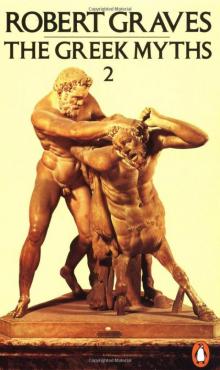 The Greek Myths, Volume2
The Greek Myths, Volume2 The Anger of Achilles: Homer's Iliad
The Anger of Achilles: Homer's Iliad Count Belisarius
Count Belisarius The Twelve Caesars
The Twelve Caesars Complete Poems 3 (Robert Graves Programme)
Complete Poems 3 (Robert Graves Programme) Homer's Daughter
Homer's Daughter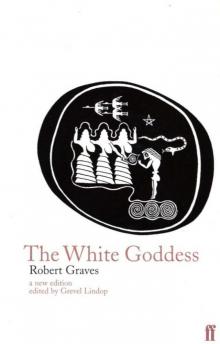 The White Goddess
The White Goddess Goodbye to All That
Goodbye to All That Claudius the God and His Wife Messalina
Claudius the God and His Wife Messalina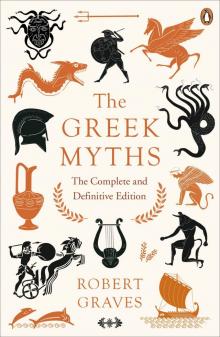 The Greek Myths
The Greek Myths I, Claudius
I, Claudius The Islands of Unwisdom
The Islands of Unwisdom Complete Short Stories
Complete Short Stories The Golden Fleece
The Golden Fleece They Hanged My Saintly Billy
They Hanged My Saintly Billy King Jesus
King Jesus Sergeant Lamb's America
Sergeant Lamb's America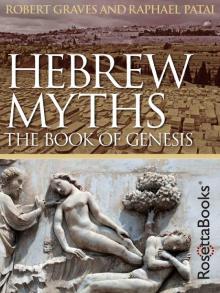 Hebrew Myths: The Book of Genesis
Hebrew Myths: The Book of Genesis Seven Days in New Crete
Seven Days in New Crete Proceed, Sergeant Lamb
Proceed, Sergeant Lamb Claudius the God
Claudius the God Wife to Mr. Milton
Wife to Mr. Milton The Complete Poems
The Complete Poems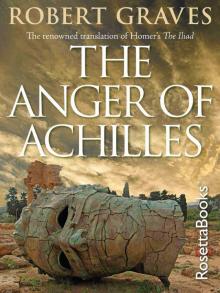 The Anger of Achilles
The Anger of Achilles Claudius the God c-2
Claudius the God c-2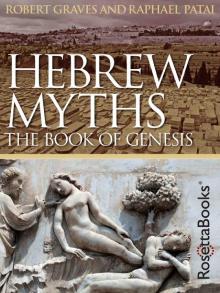 Hebrew Myths
Hebrew Myths I, Claudius c-1
I, Claudius c-1 The Greek Myths, Volume 1
The Greek Myths, Volume 1